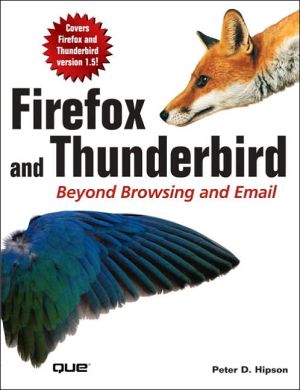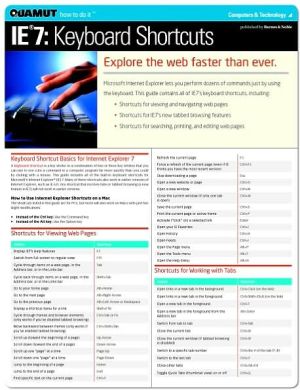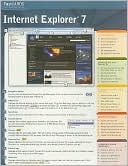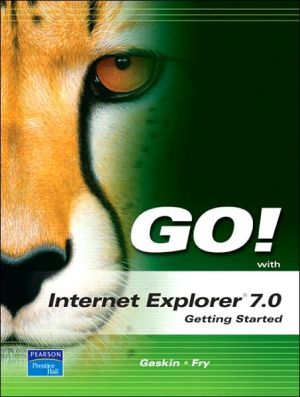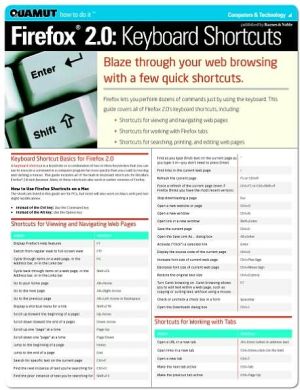Firefox and Thunderbird: Beyond Browsing and Email
There's a new browser in town: Firefox is quickly becoming a leading alternative to Microsoft Internet Explorer. If you are new to Firefox and want to see what all the buzz is about, Firefox and Thunderbird: Beyond Browsing and Email is the guide that you need. By focusing on how to configure and customize Firefox and Thunderbird, this book will show you how to quickly get a hold of the less intuitive features that most new users struggle to figure out. You will discover which of Firefox's...
Search in google:
There's a new browser in town: Firefox is quickly becoming a leading alternative to Microsoft Internet Explorer. If you are new to Firefox and want to see what all the buzz is about, Firefox and Thunderbird: Beyond Browsing and Email is the guide that you need. By focusing on how to configure and customize Firefox and Thunderbird, this book will show you how to quickly get a hold of the less intuitive features that most new users struggle to figure out. You will discover which of Firefox's many options should be adjusted, which shouldn't, and how to locate many hidden preferences that will ultimately create a better browsing experience. The author's tips and tricks will teach you how to adjust the browser's appearance and behavior, and how to install the most popular extensions to maximize the browser's performance. You'll also be introduced to Firefox's e-mail client companion, Thunderbird. You'll cover Thunderbird's built-in spam filters, calendar, and customizeable layout and toolbars. Personalize your e-mail with tips and tricks dedicated to getting the most out of Thunderbird, and learn how to make it work together with Firefox for a seamless online experience. You can even find out how to contribute to the development of Firefox and Thunderbird. A special section on Web development will show you how you can add new extensions, themes, and customizations to each one and make an impact on the future of Firefox and Thunderbird.
IntroductionIntroduction\ Maybe you are reading this in a book store, a library, or a friend's house. Maybe this is your own copy of the book. If not, you should buy it.\ Let's take a quick look at Mozilla, Firefox, and Thunderbird; the book; and what is inside for you.The Mozilla Project\ Once upon a time, a long time ago, there was an idea: "Let's connect computers together so they can share data." Shortly thereafter the first network was born.\ By 1992, the number of hosts on the Internet had grown, topping one million. Just a year before this, the first web server was created. In 1993 Mosaic was created, and a year later Mosaic Communications, which would later become Netscape Communications, was born.\ As the Internet became more popular, the Web (and email) became the mainstay of Internet usage. By 1995, Microsoft entered the scene with Internet Explorer, given away free with the Windows 95 Plus! pack add-on. By 1998, Netscape was losing market share, and AOL (who now owned Netscape) made what was considered by many to be a radical move: It decided to release the source code for Netscape as open source.\ By 2000, Mozilla was hard at work creating and enhancing the Mozilla Suite, whose browser would eventually become Firefox. Mozilla Suite's email client was also split off to become Thunderbird.\ Today, the Mozilla Organization and mozilla.org are a major force in the Internet browser and email fields. Until recently, though, Microsoft (as large companies tend to do) had ignored Mozilla, feeling that its lion's share of the browser market was safe. Today, well over 50,000,000 Internet users have taken upFirefox, making it the most viable threat to Microsoft's domination to date.The Mozilla Suite\ The Mozilla project started with Mozilla Suite, a group of programs that includes a web browser, an email and newsgroup client, an IRC chat client, and an HTML editor. The most recent release of Mozilla Suite was version 1.7.8, which was released in May 2005.\ Along the way, Mozilla Suite has spawned both Firefox (the browser) and Thunderbird (the email client). Many users have found that they don't need the full suite and only want one part, or the other. Why Firefox Now?\ Why now? Why is Firefox becoming a serious contender to Microsoft's Internet Explorer?\ When I first was introduced to Firefox, my thought was, "Great, another warmed-over copy of Netscape." I was happy with my browser and thought it was great. Then, slowly, things happened. Friends started to ask me, "Have you tried Firefox yet?" This was usually followed up with a comment that, once I tried it, I'd never be happy with that other browser again. I'll admit it took a lot of pushing. But when two people who never liked Netscape either suggested I try it, I knew something special was happening.\ I have to be fair to everyone. Firefox is not 100% perfect. (Neither is Internet Explorer, for that matter.) It has bugs, quirks, and strange behaviors that take a bit of getting used to. But once you are started with Firefox, there is no turning back.\ Will Firefox ever dominate the browser market? Truthfully, Firefox probably will not end up with 100% of the market. Internet Explorer's too entrenched, too established, and too well backed financially to fall to the wayside. But, Firefox's market share is growing at a rate that is impressive.\ Today, it is estimated that there have been about 100 million downloads of Firefox. That means Firefox has more than 10% of the worldwide browser market share. As more and more people try (and accept) Firefox, the growth potential is enormous. I would not be surprised to see Firefox's share double within the next year or two. Only time will tell....Thunderbird\ Thunderbird, a very user-friendly email client program, is also gaining market share. Even a simple look shows that Thunderbird is potentially better than Outlook Express, and while there seems to be little innovation with Outlook Express, Thunderbird continues to get better everyday.\ Thunderbird has not achieved the market penetration that Firefox has, which is only reasonable because it has not had the publicity Firefox has—yet. But usage of Thunderbird will grow as users of Firefox search for other great Mozilla products.The Mozilla Open Source Community\ Open Source is an idea where the source code for computer programs should be made freely available to users. Being freely available (the operative word being free) means products that are open source are not sold; instead they are given away.\ We do, however, have to pay a price. Perhaps if we are technically competent, we might contribute to the various projects such as Firefox and Thunderbird. Or we might make a monetary contribution or help with fundraising, evangelizing, marketing, or designing icons. The Mozilla Organization does have employees who must be paid, and that funding has to come from somewhere. Think of this as a public broadcasting pledge drive: Please contribute whatever you can. It is important.\ The Mozilla community is worldwide. Developers from virtually every country work on these projects. The common language is English, although some countries have organized groups with their own languages. If you are bilingual, consider working on a translation of one of the Mozilla products. Many locale-specific versions already exist, but there is always room for more.Who Should Read This Book?\ Who should read this book? Why, you should! This book is intended to help both the beginner and the more experienced Firefox and Thunderbird user. As such, you can start at the beginning of the book and work to the end, or if you are more experienced, you can jump directly into one of the later sections.What Is in This Book?\ I have arranged this book into parts and chapters. Both parts and chapters run from basic techniques to advanced topics, such as creating extensions and building Firefox or Thunderbird.\ Part I, "Making Firefox Yours," is your introduction to Firefox. This part covers user- oriented topics, ranging from basic techniques, to advanced changes in Firefox's look and feel.\ Chapter 1, "Hitting the Ground Running with Firefox," is an introduction to Firefox, mostly for those of us who have never used Mozilla, Firefox, or Thunderbird. This chapter takes you through downloading and installing Firefox, migrating Internet Explorer settings, and basic Firefox configuration.\ Chapter 2, "The Power of Tabs and Bookmarks," tells all about tabbed browsing and bookmarks. It covers how to open tabs; close tabs; and have multiple home pages, one in each tab.\ Chapter 3, "Finding Information with Firefox," details Firefox's extensive and powerful search capabilities. The Firefox Location bar and the built-in Firefox search bar are described, showing how to search for sites by name or by text contained on the site. This chapter also discusses how to store a search for later reuse and how to use bookmarks.\ Chapter 4, "Managing Profiles," gives you the story on setting up and modifying a user profile. Each user can have her own profile, allowing users to have different extensions, themes, and other features (such as bookmarks).\ Chapter 5, "Taking Control of Your Browser," covers the important things websites can do that affect users without their control. Firefox takes control and contains built-in tools to block pop-up ads. In addition, several important extensions are available that enhance this capability.\ Part II, "Extending and Modifying Firefox," brings on more advanced Firefox techniques. It covers extensions, themes, customization, and plug-ins, as well as a number of other useful topics.\ Chapter 6, "Power Firefox Tricks and Techniques," shows you how to customize Firefox to suit your own desires. You can control how Firefox looks using skins, which are called themes in Firefox. This chapter also covers some performance enhancements.\ Chapter 7, "Themes and Plug-ins," is dedicated to themes, which control how Firefox looks to the user, and installing some of the more popular plug-ins, such as the Adobe Acrobat Reader, QuickTime, and Real Player.\ Chapter 8, "Making Extensions Work for You," is an in-depth discussion of the user side of extensions. It talks about how to install an extension, some popular extensions, privacy and security issues, and search-related extensions.\ Chapter 9, "Changing Preferences and Settings," shows how you can use the various built-in locations, such as about:config, about:plugins, and about:cache. These built-in locations enable you to see how Firefox is currently set up, which plug-ins are in use, what the cache status is, who helped build Firefox, and other useful information.\ Part III, "Using Thunderbird," switches the focus from Firefox to Thunderbird. It starts at a basic introductory level and moves to more advanced user topics.\ Chapter 10, "Hitting the Ground Running with Thunderbird," covers the basics of Thunderbird. It explains how to download, install, and configure Thunderbird for typical users. It also covers topics such as composing emails and using the spelling checker.\ Chapter 11, "Organizing Email with Thunderbird," shows you how to organize, sort, filter, and otherwise process messages. You can label messages and group messages based on user-specified criteria. Also in this chapter is an introduction to the Thunderbird address book features.\ Chapter 12, "Fighting Spam," discusses Thunderbird's Bayesian spam filter. Thunderbird's spam fighting technology is very advanced and is one of the best available.\ Chapter 13, "Customizing Thunderbird for Power Users," covers topics such as installing themes—you can modify Thunderbird's look and feel just as you can modify Firefox's look and feel. This chapter also covers extensions and setting preferences in Thunderbird using the about:config extension.\ Part IV, "Web Development and Firefox Extensions," covers both web development and creating Firefox extensions.\ Chapter 14, "Web Development with Firefox," explains topics such as Cascading Style Sheets (which can affect the way content looks in Firefox), the JavaScript Console, and DOM (using the Document Inspector).\ Chapter 15, "Creating Your Own Theme," walks you through the process of creating a simple theme for Firefox. Themes are one way you can express your personality with Firefox. Themes for Thunderbird are very similar to Firefox themes.\ Chapter 16, "Writing an Extension," covers creating an extension that can be used with Firefox. Extensions are somewhat more complex than themes, but once the basics are mastered, they can be fun to write.\ Part V, "The Way of Mozilla for Programmers," is a look into the inner workings of the Mozilla Organization; the tools available for supporting developers; how you build the products; and the future of Mozilla, Thunderbird, and Firefox. You can find Chapters 17 19 and the Glossary on our website at http://www.quepublishing.com/title/0789734583.\ Chapter 17, "Mozilla's Tools for Developers," describes online tools such as Bugzilla (a bug management and tracking tool), Tinderbox (a tool giving the up-to-date status of the state of the Mozilla products), and LXR (a source code tool to search and find cross-references in the source). It also talks about Open Source and the various types of public licenses.\ Chapter 18, "Browsing the Code," takes you through the process of setting up a development environment for the Mozilla products. You'll find in-depth coverage of what is needed to configure your development computer, how to get the most recent source code, and the etiquette and rules for being a contributor to the Mozilla effort.\ Chapter 19, "The Future of Firefox and Thunderbird," is the final chapter. Here you will find a history of Mozilla, along with some comparisons between Firefox and Internet Explorer and a comparison between Thunderbird and the various versions of Outlook.\ \ Note - A note is an idea or action that affects how things work. Information in a note would need to be considered to get the effect suggested in the book's text. Notes are necessary information, but were a note's contents ignored, nothing would be lost—you would simply not get the results you expected.\ \ \ Tip - A tip is a suggestion that you will find makes using Firefox or Thunderbird easier. There is no reason to worry about a tip; they are just there to make things easier.\ \ \ Caution - A caution is information that, if not followed, might result in incorrect operation of the product, or even loss of data. Whenever you see a caution, read and heed its advice!\ \ From the Author\ Just a few final words before starting this book: You will see many email addresses showing in the book's figures in the domain hipson.net. These addresses were created specifically for this book and were deleted when the book was finished. Don't send email to those addresses hoping to get directly to me—it won't work! Instead, you can email me at firefox@peterhipson. com (or firefox@hipson.net). I'll try to answer all emails (especially if you are nice to me). If you have suggestions about how the book could be made better, or find any mistakes, please do send them to me.\ Both hipson.net and peterhipson.com are my domains. If you wish, visit them at http://www.hipson.net and http://www.peterhipson.com. All are located at my home, using an ADSL connection. The servers include five Dell PowerEdge servers, a hipson.net server, and a whole mess of workstations and notebooks. For a computer geek, it doesn't get any better than this.\ We have a few conventions we are using in this book. There are notes, tips, and cautions. We've included examples of each.\ Code in this book is signified using a monospaced font. Some code contains bold; in these you should read the text to determine what the bold means. Usually bold text is unique to a given user, so the example might need to be edited for your situation prior to being used.\ \ © Copyright Pearson Education. All rights reserved.
1Hitting the ground running with Firefox92The power of tabs and bookmarks313Finding information with Firefox494Managing profiles655Taking control of your browser776Power Firefox tricks and techniques1037Themes and plug-ins1318Making extensions work for you1479Changing preferences and settings16510Hitting the ground running with thunderbird18111Organizing email with Thunderbird20312Fighting spam21713Customizing Thunderbird for power users22714Web development with Firefox24915Creating your own theme26916Writing an extension289Mozilla's tools for developersBrowsing the codeThe future of Firefox and Thunderbird
